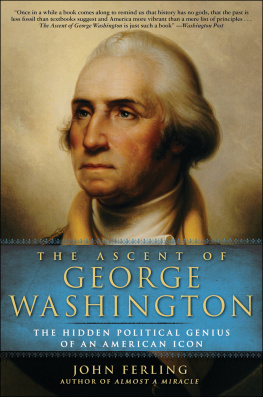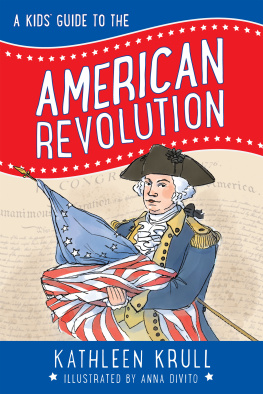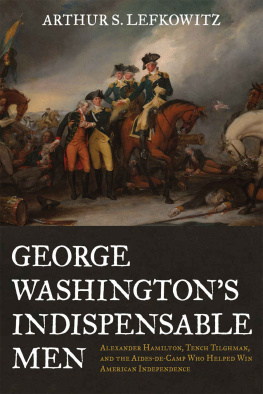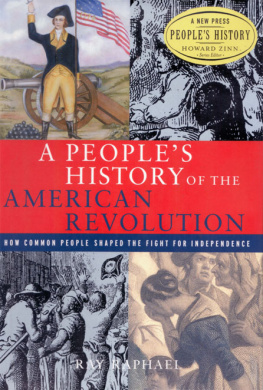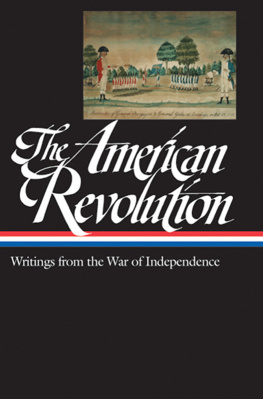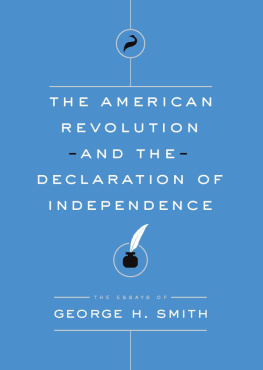A Note on the Author
John Ferling is professor emeritus of history at the University of West Georgia. A leading authority on American Revolutionary history, he is the author of eleven books, including Jefferson and Hamilton: The Rivalry That Forged a Nation ; The First of Men: A Life of George Washington ; the award-winning A Leap in the Dark: The Struggle to Create the American Republic ; Adams vs. Jefferson: The Tumultuous Election of 1800 ; Almost a Miracle: The American Victory in the War of Independence ; The Ascent of George Washington: The Hidden Political Genius of an American Icon , named one of the best books of 2009 by the Washington Post ; and Independence: The Struggle to Set America Free . He and his wife, Carol, live in metropolitan Atlanta.
By the Same Author
Jefferson and Hamilton: The Rivalry That Forged a Nation
The Ascent of George Washington: The Hidden Political Genius of an American Icon
Almost a Miracle: The American Victory in the War of Independence
A Leap in the Dark: The Struggle to Create the American Republic
Setting the World Ablaze: Washington, Adams, Jefferson, and the American Revolution
The First of Men: A Life of George Washington
Adams vs. Jefferson: The Tumultuous Election of 1800
John Adams: A Life
Struggle for a Continent: The Wars of Early America
Independence: The Struggle to Set America Free
The Loyalist Mind: Joseph Galloway and the American Revolution
A Wilderness of Miseries: War and Warriors in Early America
Chapter 10
The Campaigns of 1777
As
When Washingtons army of one-year enlistees vanished at the end of 1775, he appealed to Congress to lengthen the period of enlistment. To make men well acquainted with the Duties of a Soldier and to bring [a soldier] under proper discipline & Subordination requires time, he had counseled. Congress, awash with forebodings of standing armies, had not listened. But in the fall of 1776, with its second army about to disappear in the face of a large British force that was within a days march of Philadelphia, Congress agreed to a three-year period of enlistment, though men could still engage for shorter stretches. Congress offered enticing cash and land bounties to persuade men to sign on for lengthier service and states pitched in as well. One-third of those who enlisted in Massachusetts in 1777 agreed to long-term service. In time, Washington would command battle-hardened veterans. Congressional acquiescence to Washingtons wishes substantively transformed the Continental army. Previously, the soldiery had been something of
Although the United States may have been stronger, it faced a formidable foe, and one that in some respects was more powerful than during the campaign of 1776. Worried about French intervention the previous year, London had kept much of its fleet in home waters, so that less than 40 percent of the Royal Navy crossed to North America. But Britains successes in Canada and New York led the government to believe that the French were disillusioned with the rebels and would remain neutral. Norths government committed six additional ships of the line to America in 1777. It also sent over another six thousand redcoats, a number that came close to offsetting the losses sustained in 1776. Lord Germain, fed up with Guy Carletons lack of daring and aggressiveness, cashiered him as commander of Britains army in Canada, replacing him with General John Burgoyne, who was brimming with passion for action. Germain also conceived a well-informed strategy for gaining control of the Hudson River and winning the war.
Back in November, while Earl Cornwallis was chasing Washington across New Jersey, General Howe had crafted the initial plan for Britains campaign in 1777. Howe envisaged a feint at Philadelphia, a move that he hoped would force Washington to remain in Pennsylvania. With Washington out of the picture, Howe planned to send ten thousand men to retake Rhode Islandand bottle up hordes of Yankee soldiers in the processwhile another army of comparable size advanced up the Hudson to Albany, where it would rendezvous with the redcoats who were to invade New York from Canada. With the Hudson in hand and New England forced into the backwater of the war, the united British army would sweep across the Delaware River and reclaim the mid-Atlantic and southern colonies.
Working through Howes assorted plans, as well as one submitted by Burgoyne, Germain put together his own plan for a campaign in 1777, which he submitted to the monarch and the ministry. It was approved, though along
Howe remained inactive until June, when he wasted still more time by unavailingly marching his army to Somerset, a few miles above Princeton, in the hope of luring Washington into battle. Wiser than in 1776, and no longer concerned that Congress was breathing down his neck, Washington was not about to be drawn into an unwanted action. He remained inactive. Howe returned empty-handed to New York, where both Cornwallis and Sir Henry Clinton, the second-ranking officer in Britains army in America, inveighed against a campaign for Philadelphia and urged that the army proceed toward Albany to rendezvous with Burgoyne. Howe did not listen. He stubbornly held to his plans to campaign for Philadelphia. By the time he departed, Burgoynes army was already in New York and in trouble.
Once the ice on the St. Lawrence River broke up in late April, Burgoyne was on his way. Ten years older than Washington, Burgoyne hailed from the gentry, though by marrying the fifteen-year-old daughter of an earl, he got one foot in the door of Britains aristocracy. He had entered the army when he was fifteen, but on a couple of occasions had left the military to cope with debts that piled up from his compulsive gambling. As a soldier, Burgoyne performed with courage and valor, and his rise in the ranks was nothing short of meteoric; he vaulted from captain to brigadier general in six years. He was bright, charming, energetic, reputed to be a daring thinker in the field of military science, able at networking, and a consummate master of politics within the military establishment. Along the way, he had acted in and written plays for the theater, and he brought to bear the skills of a thespian in selling himself to key officials in London as a more forceful and intrepid warrior
Burgoyne left behind 3,800 men to defend Canada, nearly four times the number that had repulsed the rebel invasion in 1775. He also relinquished 675 men to Colonel Barry St. Leger, who was to command the Mohawk Valley enterprise. That left Burgoyne with 7,250 regulars, about 15 percent fewer than he had expected London to furnish for the invasion force. Nor was that his only disappointment. He had looked forward to being accompanied by 1,000 Native Americans, but only half that number stepped forward to join him. Furthermore, on landing at Quebec, Burgoyne found only 300 men under arms in Canadian militia and Loyalist units. He had anticipated seven times that number. Burgoyne was neither the first nor the last British general to be led astray by the belief that large numbers of zealous Tories would take up arms to fight for their king. Curiously, he was not terribly dismayed, as he confidently looked forward to an avid turnout of Tories once he crossed into New York.
Burgoynes first objective was to retake Fort Ticonderoga, which Germain had thought Carleton would capture the previous summer or fall. That the installation was not yet in British hands was due in part to Carletons unhurried and cautious habits, though the Americans had played a substantial role in keeping their enemy at bay. During the retreat from Canada in the spring of 1776, Benedict Arnold had conferred in Albany with General Schuyler, the commander of the Continental armys Northern Department. Reasoning that Carleton would have to construct a large fleet to transport his considerable army and its supplies up Lake Champlain to get at Fort Ticonderoga, Schuyler and Arnold planned the construction of a sufficient number of rebel crafts to challenge their foe. Arnold and Schuyler never imagined that they could defeat the British; instead, their object was to delay the enemys advance, forestalling any attempted invasion of New York until 1777. During the interim, the defenses at Fort Ticonderoga were to be strengthened, with an eye on making the fortress impregnable.
Next page

